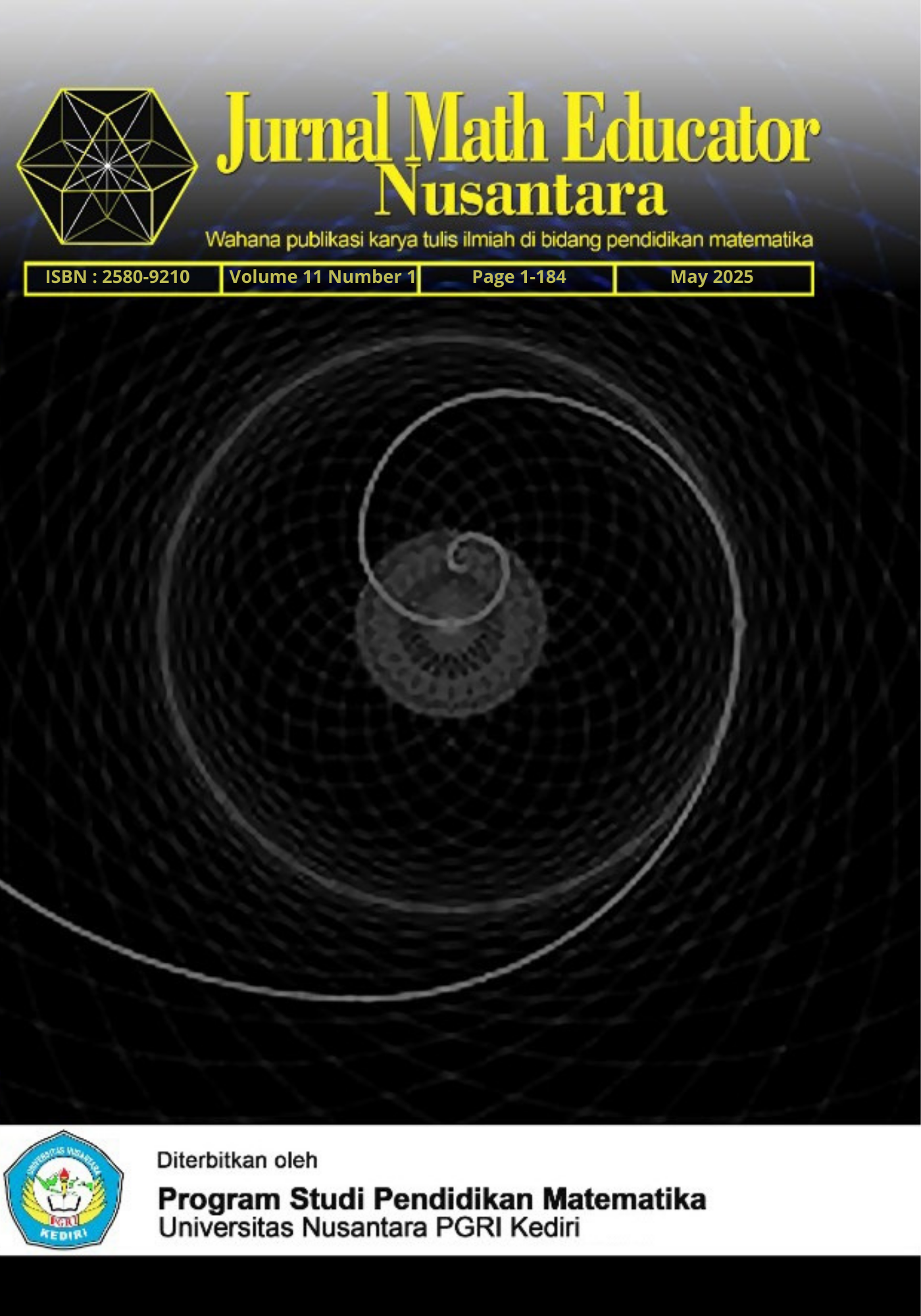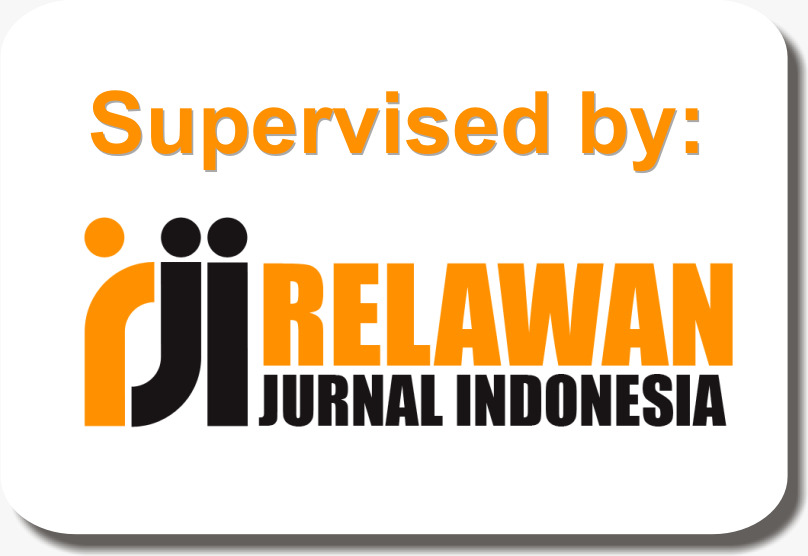CTL-Deep learning: Its influence on critical thinking skills and self-confidence in linear equation system material
DOI:
https://doi.org/10.29407/jmen.v11i1.25185Keywords:
CTL-Deep Learning, Critical Thinking, Self-Confidence, Linear Equation System, Learning ApproachAbstract
Many senior high school students have difficulty in understanding Linear Equation Systems (LES). The Contextual Teaching and Learning-Deep Learning (CTL-DL) approach is one of the current solutions. This study aims to describe the effect of the CTL-DL approach on students' critical thinking skills and self-confidence in the material of Linear Equation Systems. This quasi-experimental study with a pretest-posttest control group design used a population of class X students of SMA Negeri 2 Yogyakarta in the 2024/2025 academic year. Sampling was carried out by purposive sampling. Data were collected using observation sheets, critical thinking ability tests, and self-confidence questionnaires, then analyzed using the Multivariate Hotelling's T² statistical test and the independent t-test at a significance level of 0.05. The results of the study showed: 1) there was an influence of the CTL-DL approach on students' critical thinking skills and self-confidence, 2) the CTL-DL approach was significantly superior to the expository approach in improving critical thinking skills, and 3) the CTL-DL approach was significantly superior to the expository approach in improving students' self-confidence
References
Apriyanti, M., Suweken, G., & Suparta, I. N. (2019). Development Of Hypothetical Learning Trajectory For Linear Equations With Pisa And Scientific Approach Model Consideration. Journal of Mathematics and Science Teaching, 24(2), 78–86. https://doi.org/10.18269/jpmipa.v24i2.15856
Bai, B. (2023). The role of growth mindset, self-confidence and intrinsic value in self-regulated learning and English language learning achievements. Language Teaching Research, 27(1), 207–228. https://doi.org/10.1177/1362168820933190
Bisong, E. (2019). Building Machine Learning and Deep Learning Models on Google Cloud Platform: A Comprehensive Guide for Beginners. In Apress Media LLC. https://doi.org/10.1007/978-1-4842-4470-8_29
Boob, A., & Radke, M. (2024). Leveraging two-level deep learning geometry classifiers for 2D shape recognition to automatically solve math word problems. Pattern Analysis and Applications, 27, 3. https://doi.org/10.1007/s10044-024-01321-9
Calista, D. A., Rusijono, R., & Dewi, U. (2022). The Influence of Contextual Teaching and Learning on Higher Order Thinking Skills of Geometry of Spatial Buildings. Akademika, 11(01), 23–31. https://doi.org/10.34005/akademika.v11i01.1907
Dwi, P., Retno, D., & Saputro, S. (2013, 2013). The Analysis Of Students' Difficulties In Solving Systems Of Linear Equations in Two Variables. 4th ICRIEMS Proceedings Published by The Faculty Of Mathematics And Natural Sciences Yogyakarta State University,
Facione, P. A. (2015). Critical thinking: What it is and why it counts. Insight assessment, 1(1), 1-23. www.insightassessment.com
Field, A. (2023). Discovering statistics using IBM SPSS Statistics (6th ed.). SAGE Publications.
Fitriani, N. (2024). Pengaruh model active learning terhadap motivasi dan hasil belajar siswa sekolah dasar. Jurnal Inovasi Pendidikan, 15(1), 22–30.
Gravemeijer, K. (2008). RME Theory and Mathematics Teacher Education. In International Handbook of Mathematics Teacher Education (Vol. 1 283, pp. 283–302).
Hankeln, C. (2021). Combining and Contrasting Formal Concept Analysis and APOS Theory. Educational Studies in Mathematics, 105(1), 1–14. https://doi.org/10.1007/s10649-018-9859-7
Hawkes, P. W. (2023). Deep learning, pros and cons, mathematics vs physics, spiritualists vs physicists. Ultramicroscopy, 250. https://doi.org/10.1016/j.ultramic.2023.113748
Herawaty, D., Widada, W., Falaq, A., Anggoro, D., Dewarif, S., & Anggoro, T. (2021). Overcoming Difficulties in Understanding the Linear Equation System Through the Ethnomathematics Approach in the COVID-19 Pandemic. Advances in Social Science, Education and Humanities Research, 532, 129–137.
Hobri, S., I, & Prihandoko, A. C. (2018). High-order thinking skills in contextual teaching and learning of mathematics based on lesson study for learning communities. International Journal of Engineering and Technology(UAE, 7(3), 1576–1580. https://doi.org/10.14419/ijet.v7i3.12110
Istiqomah, N., & Mariani, S. (2020). Mathematics literacy ability reviewed from cognitive style on project based learning with rme approach assisted by schoology. International Journal of Scientific and Technological Research, 9(3), 5338–5345. https://www.scopus.com/inward/record.uri?eid=2-s2.0-85083092127&partnerID=40&md5=0e18e1bf935f865a9284ae0bac5de9b3
Jayasundera, A., & Allam, Z. (2024). Investigating Leadership Competencies and Self Efficacy in Bahrain's Business Process & IT Consulting Firm: A Case Study for SME Success. Journal of Ecohumanism, 3(3), 981–998. https://doi.org/10.62754/joe.v3i3.3400
Khoirudin, M., Hobri, I., M, G., E, & Purwandi, D. (2020). Students' metacognitive abilities in contextual teaching and learning of mathematics based on jumping tasks. Journal of Physics. https://doi.org/10.1088/1742-6596/1538/1/012109
Khotimah, R. P., & Masduki, M. (2016). Improving Teaching Quality and Problem Solving Ability Through Contextual Teaching and Learning in Differential Equations: A Lesson Study Approach. JRAMathEdu (Journal of Research and Advances in Mathematics Education, 1(1), 1–13. https://doi.org/10.23917/jramathedu.v1i1.1791
Kumari, L., Priti, C., & Sharma, N. (2023). Measuring the effectiveness of deep learning in STEM education: A comparative analysis of student outcomes and engagement. In STEM: A Multi-Disciplinary Approach to Integrate Pedagogies, Inculcate Innovations and Connections (pp. 163–174). Nova Science Publishers, Inc. https://www.scopus.com/inward/record.uri?eid=2-s2.0-85183502407&partnerID=40&md5=2d1496a05ebc3370769695d12a253444
N.c.t.m. (2010). Principles and Standards for School Mathematics. In NCTM. http://journal.um-surabaya.ac.id/index.php/JKM/article/view/2203
Nugraheni, N., & Sukestiyarno, Y. L. (2022). Student's Learning Independence Profiles in Solving HOTS Questions Related to Numeracy. Journal of Higher Education Theory and Practice, 22(15), 20–29. https://doi.org/10.33423/jhetp.v22i15.5557
Nugroho, K. U. Z., Izwanto, E., Widada, W., Alias, N., Falaq, A., Anggoro, D., Herawaty, D., Jumri, R., Dewarif, S., & Aggoro, T. (2023). The Relationship among Self-confidence, Concept Understanding, Creative Thinking Ability, Mathematical Problem-Solving Ability, and Mathematics Learning Outcomes. EDUMATIKA: Journal of Mathematics Education Research, 6.
Nuha, M. A., Waluya, S. B., & Junaedi, I. (2018). Mathematical creative process model in students problem posing with lesson study approach. International Journal of Instruction, 11(2), 527–538. https://doi.org/10.12973/iji.2018.11236a
Nurhayati, L., & Setiawan, D. (2020). Pendekatan holistik dalam pendidikan: Integrasi ranah kognitif dan afektif dalam proses pembelajaran. Jurnal Pendidikan Holistik, 4(1), 12–20.
Nurmawanti, I., Darmiany, D., Gunawan, G., Radiusman, R., & Haryati, L. F. (2021). Misconceptions in Linear Equation Systems: The Case of Students Using Imitative Reasoning. Journal of Physics. https://doi.org/10.1088/1742-6596/1779/1/012076
Pečiuliauskienė, P. (2023). Instructional clarity in physics lessons: Students' motivation and self-confidence. Cogent Education, 10(2). https://doi.org/10.1080/2331186X.2023.2236463
Priliawati, E., Slamet, I., & Sujadi, I. (2019). Analysis of junior high school students' errors in solving HOTS geometry problems based on Newman's error analysis. Journal of Physics: Conference Series, 1321, 3. https://doi.org/10.1088/1742-6596/1321/3/032131
Purwanti, K. L., & Waluya, B. (2019). Mathematical literacy ability with RME (realistic mathematics education) approach in fifth grade students. Journal of Physics. https://doi.org/10.1088/1742-6596/1321/2/022118
Putra, R., Surya, E., & Setiawan, D. (2024). Improve High Order Thinking Students through Contextual Teaching Learning Based on Cognitive Distance. International Journal of Religion, 5(11), 1741–1752. https://doi.org/10.61707/wpk8d874
Rad, M. R., & Davis, J. L. (2024, 2024). Exploring Student Perceptions of Learning Experience in Fundamental Mechanics Courses Enhanced by ChatGPT ASEE Annual Conference and Exposition, Conference Proceedings, https://www.scopus.com/inward/record.uri?eid=2-s2.0-85202073698&partnerID=40&md5=1bc602d8bb45d2fd053fd13692121bd2
Sari, D. K., & Putri, R. A. (2023). Penerapan pendekatan contextual teaching and learning dalam meningkatkan hasil belajar siswa. Jurnal Pendidikan dan Pembelajaran, 12(1), 45–53.
Sarifah, I., Kuswati, E., Suniasih, W., Fahrurrozi, F., & Susilo, G. (2024). Cognitive Test Instruments to Measure Student Mathematics Ability in Elementary School: Rasch Analysis. Educational Administration: Theory and Practice, 30(4), 767–779. https://doi.org/10.53555/kuey.v30i4.1557
Selvianiresa, D., & Prabawanto, S. (2017). Contextual Teaching and Learning Approach of Mathematics in Primary Schools. Journal of Physics: Conference Series, 895(1). https://doi.org/10.1088/1742-6596/895/1/012171
Sufianto, S. (2019). The Effect of Contextual Teaching And Learning (CTL) Learning Model on The Ability Of Concept Understanding Class VII Students of SMP 16, Bengkulu City. Raflesia Journal of Mathematics Education, 4(1), 19–28. https://doi.org/10.33449/jpmr.v4i1.7525
Sulistiani, E., & Waluya, S. B. (2018). The analysis of student's critical thinking ability on discovery learning by using hands on activity based on the curiosity. Journal of Physics: Conference Series, 983(1). https://doi.org/10.1088/1742-6596/983/1/012134
Susanto, H., & Wijaya, A. F. (2022). Penerapan pendekatan contextual teaching and learning berbasis digital untuk meningkatkan kepercayaan diri dan hasil belajar siswa. Jurnal Teknologi Pendidikan, 24(2), 101–110.
Syam, H., Sutawidjaja, A., & Sa'dijah, C. (2020). Junior high students' critical thinking in geometry problem solving. Universal Journal of Educational Research, 8(11), 5880–5887. https://doi.org/10.13189/ujer.2020.082221
Syamsuddin, S., & Istiyono, E. (2018, 2018). The effectiveness of mathematics learning through contextual teaching and learning approach in Junior High School AIP Conference Proceedings, https://doi.org/10.1063/1.5054489
Team, R. (2020). RStudio: Integrated development for R. In RStudio PBC.
Team, R. C. (2024). R: A language and environment for statistical computing (4.4.1. R Foundation for Statistical Computing.
Trigueros, M., Possani, E., Lozano, M. D., & Sandoval, I. (2009, 2009). Learning Systems Of Linear Equations Through Modelling Proceedings of the 33rd Conference of the International Group for the Psychology of Mathematics Education,
Widada, W., Herawaty, D., Rahman, M. H., Yustika, D., & Elsa, P. (2020). Overcoming the difficulty of understanding systems of linear equations through learning ethnomathematics. IOP Conf. Series: Journal of Physics, 1–14. https://doi.org/10.1088/1742-6596/1470/1/012074
Wulandari, E. Y., & Alyani, F. (2022). Self-regulated learning and problem-solving abilities of elementary school students in fraction during online learning. Journal of Elements, 8(2), 645–658. https://doi.org/10.29408/jel.v8i2.5708
Yudha, A. (2019). The Influence of Contextual Teaching and Learning (CTL) Model with Scaffolding on Mathematical Connection Ability at SMP Negeri 6, Bengkulu City. Raflesia Journal of Mathematics Education, 4(1), 79–83. https://doi.org/10.33449/jpmr.v4i1.7533
Zetriuslita, Z., Wahyudin, W., & Dahlan, J. A. (2018). Association Among Mathematical Critical Thinking Skill, Communication, and Curiosity Attitude As the Impact of Problem-Based Learning and Cognitive Conflict Strategy (Pblccs) in Number Theory Course. Infinity Journal, 7(1), 15. https://doi.org/10.22460/infinity.v7i1.p15-24
Zulyadaini, D. (2017). A Development of Students' Worksheet Based on Contextual Teaching and Learning. IOSR Journal of Mathematics, 13(01), 30–38. https://doi.org/10.9790/5728-1301033038
Downloads
Published
Issue
Section
License
Copyright (c) 2025 Amelia Anggraini, Elly Arliani

This work is licensed under a Creative Commons Attribution 4.0 International License.
Authors who publish with this journal agree to the following terms:
- Copyright on any article is retained by the author(s).
- The author grants the journal, the right of first publication with the work simultaneously licensed under a Creative Commons Attribution License that allows others to share the work with an acknowledgment of the work’s authorship and initial publication in this journal.
- Authors are able to enter into separate, additional contractual arrangements for the non-exclusive distribution of the journal’s published version of the work (e.g., post it to an institutional repository or publish it in a book), with an acknowledgment of its initial publication in this journal.
- Authors are permitted and encouraged to post their work online (e.g., in institutional repositories or on their website) prior to and during the submission process, as it can lead to productive exchanges, as well as earlier and greater citation of published work.
- The article and any associated published material is distributed under the Creative Commons Attribution-ShareAlike 4.0 International License
















